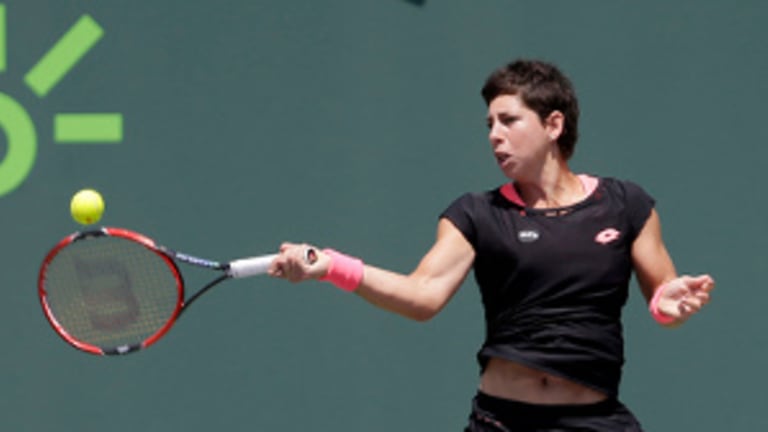Carla Suarez Navarro, her cheeks nearly as red as the clay under her feet, shuffles slowly toward the baseline to serve. At 5’4”, she’s one of the least-intimidating presences among the top tier of women players, and she doesn’t do much, body-language-wise, to alter that impression. By the end of her two-set win over Petra Kvitova on Friday in Rome, Suarez Navarro is breathing hard, her shoulders are slumped, and she barely picks her feet up off the court as she moves around between points. All of which, if you consider the fact that she played a long, three-set match the previous day, might make you think she’s a little weary.
Then the rally begins.
Suarez Navarro starts with her famed topspin backhand. It’s the only one left in the WTA’s Top 40, but that isn’t why it’s among the most celebrated strokes on either tour. Like virtually all one-handers worth remembering, Suarez Navarro's is hit with an easy motion and a gloriously high take-back. Most distinctive about hers is the extra, exclamatory wrist snap that she adds at the very end, like a tail with a sting in it. More important for her game, of course, is the fact that she can do anything with the shot—flick it crosscourt, drive it down the line, come over or under it. Like just about everything Suarez Navarro does on a tennis court, her backhand is unassuming in its flair and effectiveness.
On the next shot, Suarez Navarro slides to her right for a forehand. While it’s not as lionized as her backhand (forehands never are), it has the same spin and versatility. Suarez Navarro can send it high and deep with heavy topspin, or knock it off for winners. While her backhand earns rave reviews from tennis aesthetes, she’ll still run around it to crack a forehand when she has the chance.
Suarez Navarro hits this forehand crosscourt, and Kvitova responds with a drop shot, which gives us a chance to see another unassuming, and perhaps under-appreciated aspect of Suarez Navarro’s game: Her movement. It’s especially good on clay, because, as with any self-respecting Spanish player, sliding is second nature to her. No matter what surface she's on, though, Suarez Navarro has what they call “court sense”: the gifted tennis player’s knack for materializing wherever the ball is, and never looking hurried when she gets to it. Kvitova’s drop shot isn’t bad, but Suarez Navarro is there, with a long slide, to shovel it down the line.
This leaves her at the net, a place where, unlike many of her colleagues, she knows how to handle herself. Suarez Navarro is ranked No. 10 in singles at the moment, and No. 12 in doubles, and the volley practice pays off today. Kvitova slugs a crosscourt forehand pass that looks briefly as if it will go for a winner. But Suarez Navarro makes a stabbing volley that caroms up in the air, over the net, and an inch inside the sideline for a winner. She apologizes—the ball may have come off her frame—but Kvitova applauds anyway. She knows that Suarez Navarro doesn’t need to be lucky to make this shot. One point later, the Spaniard curls a backhand pass just inside the same sideline to beat the Czech for the fourth straight time.
